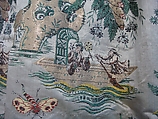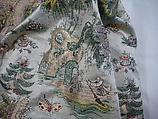Returned to lender The Met accepts temporary loans of art both for short-term exhibitions and for long-term display in its galleries.
Dress (Robe à la Française)
France; Textile: Possibly Dutch, ca. 1730
Not on view
The Dutch brocaded satin of this dress dates to the 1730s, when designs with large patterns showing architectural motifs, genre scenes, and landscapes with enormous flowers were popular for dress fabrics. In this example, the rocky islands that bloom with fantastic oversized flora demonstrate a familiarity with printed chinoiserie designs. The prominence of the fanciful boats carrying Asian figures may refer to the crucial maritime links between Europe and the exotic East. Because of the enduring appeal of chinoiserie and the expense of the silk fabric, the dress was altered into this more form-fitting style about 1770.
Due to rights restrictions, this image cannot be enlarged, viewed at full screen, or downloaded.
This artwork is meant to be viewed from right to left. Scroll left to view more.




